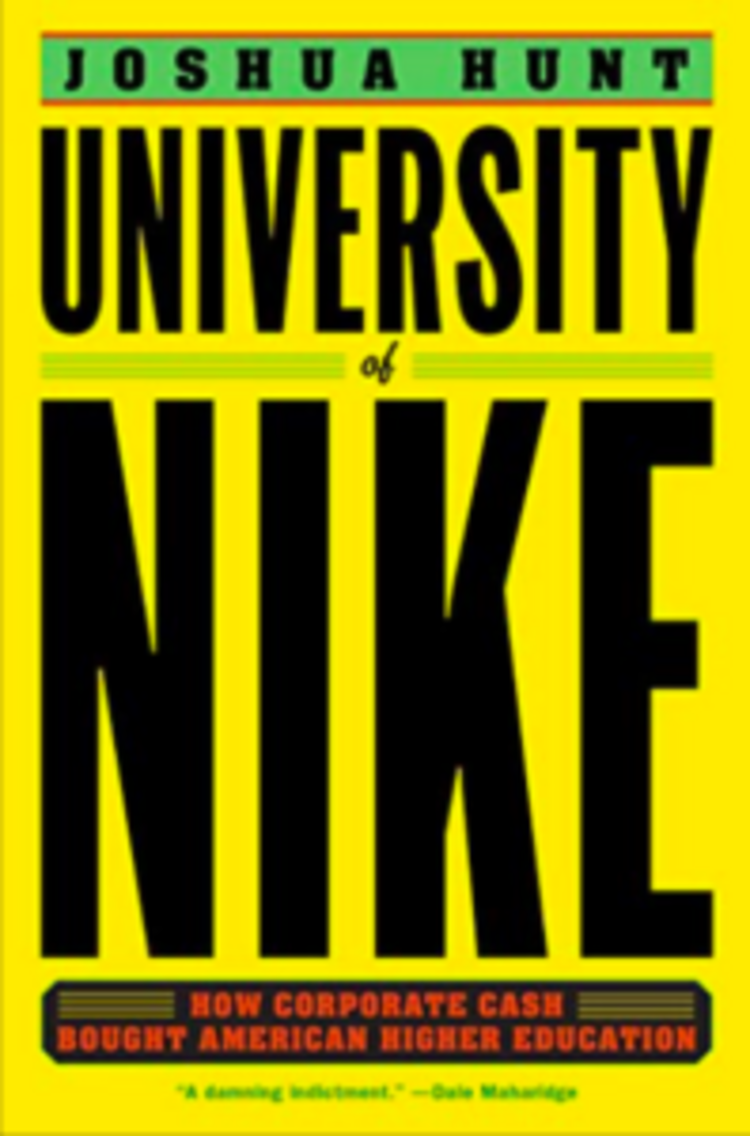Book Review: University of Nike
Eric Howanietz #analysis #book review
Old News, Same Nike
Joshua Hunt’s University of Nike is not a new story, but a legacy of corruption that shows no sign of changing or even slowing down. It can be difficult to come to grips with the reality that the students of UO are immersed in an active model for the privatization of public universities.
So much of the institution that UO students have invested in is built upon the sweatshop labor of women and children trapped in perpetual poverty. The University of Nike was published in 2018 and lives up to its reviews as a damning indictment of the University of Oregon and the founder of Nike: Phil Knight. Though the initial shock waves it created are now beginning to pass, the ongoing reality of the University of Nike is something that the whole university and the Eugene community are completely besieged by.

The University of Oregon is a checkerboard of outlandish and decadent corporate-controlled construction projects. Each of these brings its influence to bear upon the administrative policy and academic rigor of the institution. None more so than the legacy of rape that Nike’s influence has engendered in UO’s athletics. Hunt’s book shows a national trend towards defunding education that paves the way for privatization. Corporate-sponsored research and sports apparel branding of college athletics then became a major vector for private donations to influence research, policy, and budget priorities at countless American universities.
But what Hunt’s book shows is that UO became a test bed for some of the most convoluted extremes of public/private entanglement. In many ways, the University of Oregon has become an extension of the Nike brand, with over 80 communications and public relations staff managing its corporate-crafted image.
Where this blurred line between corporate branding and academic reputation has had its most violent effect is on the rape culture of UO’s athletics and the documented history of overt and continual administration coverups. With millions on the line, administration and athletic staff are disincentivized from holding athletes to account for rape allegations.
Hunt goes out of his way to name names and a surprising number of staff involved in past cover-ups are still employed by the university. During the 2014 UO Basketball Team gang rape case, the Director of Counseling Shelly Kerr handed over the victim’s therapy notes to UO’s general legal counsel as it prepared for an impending lawsuit. The disclosure of the victim’s therapy notes violated countless medical privacy laws.
Additionally, the UO police department did not publicly acknowledge the assault for over seven weeks. Immediately upon being notified of the allegations against the star basketball players UOPD contacted administration and waited for guidance. The three players accused of the rape Brandon Austin, Damyean Dotson, and Dominic Artis were allowed to continue to play through that year’s NCAA tournament even while administration was aware of the accusations. UO was more concerned with its media strategy surrounding the controversy than any justice for the victim.
Another figure Hunt notes, Lisa Thornton, is still in the public records office and regularly takes her orders from UO’s Public Relations department. This has made any release of documents through the Freedom of Information Act (FOIA) a constant struggle for journalists and academics (as the Insurgent can attest).
One whistle blower even said, “Lisa was particularly afraid that the public-relations department would get mad at her… They have a lot of clout at the university.”
In the end the capricious and avarice character of Phil Knight has been completely exposed by Hunt. It’s even clear that Knight had former UO president David Frohnmayer held hostage and acted on threats to pull millions in donations from Fanconi Anemia research, a genetic disease of which three of Frohnmayer’s daughters died. Such shocking acts by Knight directly pressured Frohnmayer into pulling out of the Worker Rights Consortium (WRC).
UO campus activists were at the center of a huge international movement in the early 2000’s to hold corporations accountable for sweatshop conditions. UO’s membership in the WRC was a keystone of that movement on American campuses. The pressure Knight’s various donations brought to bear on UO ultimately broke the back of the anti-sweatshop movement at universities.
Because of Phil Knight and Nike’s legacy, the University of Oregon is built on the back of sweatshop labor.
If Hunt’s critique is lacking, it is that it failed to illustrate how Nike opened the door for Neo-liberal raiding from a rogue’s gallery of corporations each with their own interests and agendas. He does fail to give context to how UO’s Board of Trustees was turned into an all-you-can-eat buffet of corporate interests where donors now directly assert control over the university. This used to be taboo, the power and the money were supposed to at least appear separate.
Big donors traditionally congregated in university foundations, and the governing of the university was conducted by a Board of Trustees whose priority was the public interest of students, staff, and faculty. Much of the back-room dealings, that led to the Oregon university system restructuring under Oregon Senate Bill 270, are not touched on by Hunt.
But I really can’t blame him for focusing on UO’s biggest and most controversial donor.
At the University of Oregon, the line between the foundation and the Board of Trustees has become so incestuous it’s hard to tell the difference. The impact of these funding and policy priorities is felt by students and negatively affects the learning and social environment of UO. University privatization has led to violent gentrification of the Eugene community and threatens the academic integrity of its departments. Most of all, it has prevented the anti-sweatshop & anti-globalization movement from gaining ground on American campuses for the last 20 years.
Get the book from the UO library or at the ROAR office in the EMU